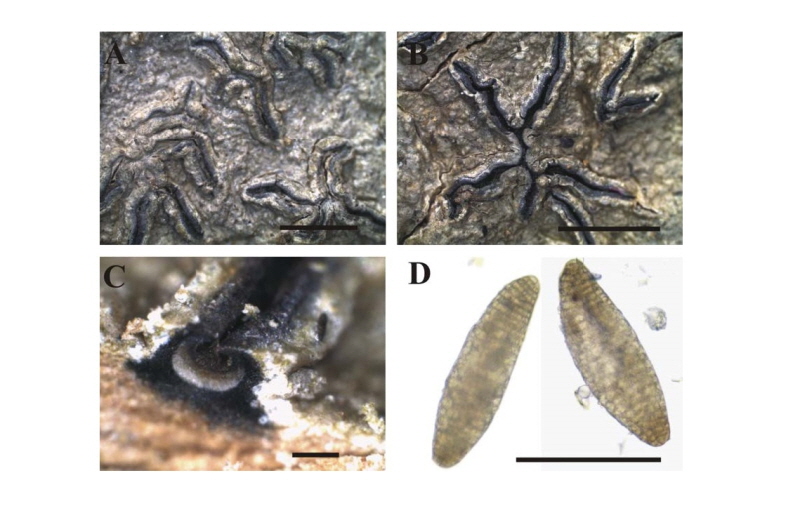A study of specimens of the genus Graphis Adans., collected during a field trip organized in 2015 in the western part of Cameroon, revealed several noteworthy species [1]. From the bulk of the collected material, we found an interesting species. This species is remarkable among other Graphis species in its montane habitat and unique taxonomical characteristics, including a carbonized proper exciple thick at the base and ascospores becoming yellowish at maturity, found rarely in the genus. A detailed study and subsequent comparison with other species showed that the material differed from any currently known species of Graphis. Therefore, it is described here as the new species Graphis lueckingiana.
The material was deposited in the herbarium of the Korean Lichen Research Institute (KoLRI), Sunchon National University. Morphological characteristics were examined using a stereomicroscope (Nikon SMZ645; Nikon, Tokyo, Japan) and a compound microscope (Nikon Eclipse E200) at higher magnifications of 40× and 1,000× prior to KOH application. Lugol’s iodine solution was used to check the amyloidity of ascospores. All measurements were obtained from material mounted in water. Chemistry was analyzed following the procedure of Orange et al. [2].
Graphis lueckingiana S. Joshi, Upreti & Hur sp. nov. (Fig. 1)
MycoBank No.: MB826960
This species is close to Graphis elixiana, but differs by large ascospores and lacking lichen substances in thallus.
Type: Africa, Cameroon, North-West Region, Mount Oku, Kilum forest, (N06°12'13.88'', E10°30'53.27''), elev. 2765 m, on bark of Prunus sp., 09 May 2015, Jae–Seoun Hur, CR150182 (KoLRI 036241—holotype).
Description: Thallus corticolous, crustose, greyish-green to grey, greenish-grey, glossy, continuous, uneven, ± verruculose, up to 200 μm thick, corticate; cortex, distinct, continuous, 15~25 μm thick; algal layer trentepohlioid, distinct, continuous, 50~75 μm thick; medulla white, crystalline, mostly endoperidermal; prothallus indistinctly dark brown.
Apothecia lirellate, prominent, short and broad, 1~1.5 × 0.3~0.6 mm, stellately branched; labia entire, mostly invisible; thalline margin complete, apically thick (illinata-morph), becoming thinner or eroded apically in over mature lirellae, 150~180 μm thick; disc concealed to slightly exposed due to over-maturity, brownish, epruinose; proper exciple convergent, completely carbonized, laterally 50~60 μm, basally up to 200 μm thick; epihymenium brownish, granular, 10~15 μm high; hymenium hyaline, densely inspersed with small oil-droplets lining 2~4 μm thick paraphyses and not dissolving in KOH, up to 200 μm high; subhymenium hyaline, indistinct to 25 μm high; asci broadly clavate, 1-spored, 170~215 × 60~90 μm, I–; ascospores broadly fusiform with round ends to ellipsoidal, multicelled, muriform, hyaline to yellowish, 145~185 × 35~55 μm, I+ blue-violet.
Chemistry: K–, PD–, C–; no lichen substance detected by TLC.
Etymology: The specific name refers to the prominent lichenologist Dr. Robert Lücking (Berlin, Germany).
Distribution and ecology: Graphis lueckingiana grows on thinned barked trees in humid to subhumid areas of Mount Oku. This mountainous region includes the largest volcano in the western high plateau of Cameroon and forms the largest remaining patch of montane forest in West Africa [3-4]. Because host trees are common and abundant in the mountainous region, G. lueckingiana is a ubiquitous lichen species. We used only representative specimens for the documentation. The new taxon was collected at an elevation of 2,745 m with other associated members of Graphis and Pertusaria.
Remarks: Although, Graphis lueckingiana occupies large portions of individual trunks, it can easily be intermingled with the greyish bark texture of several trees of Mount Oku, and likely to be overlooked if not actively searched for. Characteristically, this species seems to be widespread in forest patch. The new taxon possesses greyish-green, glossy, uneven, continuous thallus, stellately branched lirellae, entire labia covered completely with thick thalline margin, completely carbonized proper exciple considerably thick at the base, one-spored asci and muriform hyaline to yellowish ascospores.
Graphis elixiana A. W. Archer is nearest to the new taxon among different species that have been described previously with an entire labia, completely carbonized proper exciple, inspersed hymenium and muriform hyaline to pale-brown ascospores. However, G. elixiana contains hirtifructic and ß–orsellinic acids and atranorin as lichen substances. Further, it produces comparatively smaller ascospores of (90~)102~130 × (12~)14~17 μm [5-6]. Graphis phaeospora Vain. and G. argentata Lücking & Umañ are close to G. lueckingiana in lacking lichen substances, but the two species have smaller ascospores and different lirellae morphology (Table 1).
|
Table 1. Characteristics distinguishing Graphis lueckingiana (holotype) from relative species. 
|
|
|
Source of description [6, 7]. |
|
Additional specimen examined: Africa, Cameroon, Northwest region, Mount Oku, Kilum forest, (N06°10'58.44'', E10°30'33.95''), elev. 2745 m, on bark of Prunus, 09 May 2015, Jae-Seoun Hur, CR150181 (KoLRI 036240).



